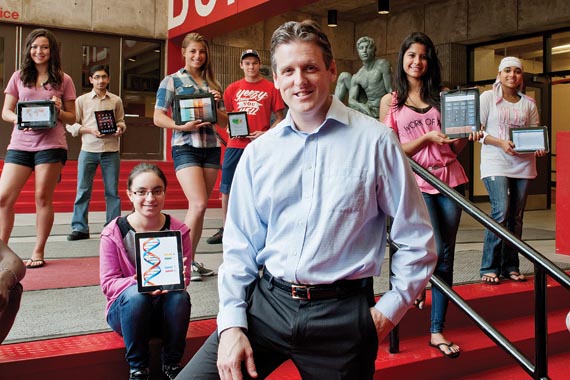School Leadership 2.0
A Network Connecting School Leaders From Around The Globe
7 Habits of Highly Effective Tech-leading Principals
T.H.E. Journal
http://thejournal.com/Articles/2012/06/07/7-habits-of-highly-effect...
By Jennifer Demski - 06/07/12
Patrick Larkin, principal of Burlington High School in Burlington, MA, started a 1-to-1 iPad initiative in the fall of 2012.
The conventional wisdom in education is that any school reform--be it curriculum, instruction, assessment, or teacher professionalism--is most likely to take hold in schools that have strong leadership. The same holds true for technology. Any educator will tell you the most successful implementation of technology programs takes place in schools where the principal sees him or herself as a technology leader.
"The role of the principal is one of facilitation and modeling behavior," remarks Robert Farrace, senior director of communications and development with the National Association of Secondary School Principals. "The principal who models these behaviors is going to be able to inspire innovation in their school much more effectively than a principal who simply requires that teachers use technology, or collaborate, or take risks."
T.H.E. Journal recently surveyed principals from across the country to identify the attributes they think a principal who wants to be an effective technology leader should demonstrate. The consensus settled on the seven attributes most frequently mentioned. They constitute our list of "Seven Habits." At the same time, we solicited Farrace's expert insight into why each of these habits is important.
We then spoke with three highly effective technology leaders among the ranks of principals to see how these habits have led to the successful implementation of educational technology in their schools. Patrick Larkin, of Burlington High School in Burlington, MA, and Eric Sheninger, of New Milford High School in New Milford, NJ, were recently recognized as NASSP Digital Principals. Lyn Hilt is both the principal and technology integrator at Brecknock Elementary School in Denver, PA. She and Larkin will speak on the topic of 21st century leadership at ISTE 2012.
1. Create an Atmosphere That Inspires Innovation
2. Foster Collaboration
3. Be Open to New Ideas
4. Be a Connected Learner Yourself
5. Locate and Provide Adequate Resources
6. Take Risks
7. Have a Visionary Focus
Read the full article here, with expert perspectives and examples of each habit in practice.
JOIN SL 2.0
SUBSCRIBE TO
SCHOOL LEADERSHIP 2.0
Feedspot named School Leadership 2.0 one of the "Top 25 Educational Leadership Blogs"
"School Leadership 2.0 is the premier virtual learning community for school leaders from around the globe."
---------------------------
Our community is a subscription-based paid service ($19.95/year or only $1.99 per month for a trial membership) that will provide school leaders with outstanding resources. Learn more about membership to this service by clicking one of our links below.
Click HERE to subscribe as an individual.
Click HERE to learn about group membership (i.e., association, leadership teams)
__________________
CREATE AN EMPLOYER PROFILE AND GET JOB ALERTS AT
SCHOOLLEADERSHIPJOBS.COM
New Partnership
Mentors.net - a Professional Development Resource
Mentors.net was founded in 1995 as a professional development resource for school administrators leading new teacher induction programs. It soon evolved into a destination where both new and student teachers could reflect on their teaching experiences. Now, nearly thirty years later, Mentors.net has taken on a new direction—serving as a platform for beginning teachers, preservice educators, and
other professionals to share their insights and experiences from the early years of teaching, with a focus on integrating artificial intelligence. We invite you to contribute by sharing your experiences in the form of a journal article, story, reflection, or timely tips, especially on how you incorporate AI into your teaching
practice. Submissions may range from a 500-word personal reflection to a 2,000-word article with formal citations.

You need to be a member of School Leadership 2.0 to add comments!
Join School Leadership 2.0